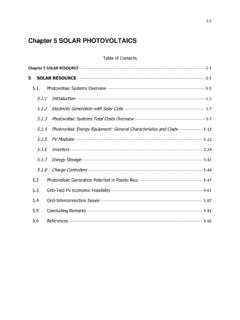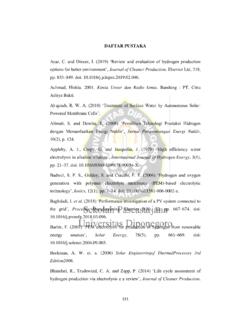Transcription of GRID-CONNECTED PV SYSTEMS
1 GRID-CONNECTED PV SYSTEMS SYSTEM DESIGN GUIDELINESThe development of this guideline was funded through the Sustainable Energy Industry Development Project (SEIDP). The World Bank through Scaling Up Renewable Energy for Low-Income Countries (SREP) and the Small Island Developing States (SIDSDOCK) provided funding to the PPA as the Project Implementation Agency for the SEIDP. The guidelines have been developed by Global Sustainable Energy Solutions with the support of Dr Herbert Wade and reviewed by PPA and SEIAPI Technical guidelines have been developed for The Pacific Power Association(PPA) and the Sustainable Energy Industry Association of the Pacific Islands (SEIAPI).They represent latest industry BEST PRACTICE for the design of Grid Connected PV SYSTEMS Copyright 2019 While all care has been taken to ensure this guideline is free from omission and error, no responsibility can be taken for the use of this information in the design of any grid connected PV Standards Relevant to Design of Grid Connected PV Steps when Designing a Grid Connected PV Site Selecting a Solar Choosing an Array Energy Output of a Solar Solar Effect of Orientation and Shading of Factors Affecting the Solar Module s Power Derating Solar Modules Power Inverter How Many Inverters?
2 Selecting the Size of Matching Array Power to the Matching Array Voltage to the Minimum Number of modules in the Maximum number of modules in the Matching Array current to the Electrical Losses in the Grid connected PV Energy Effect of Specific Performance Providing a 1: Temperature Conversion 2: Solar Irradiation Appendix 3: Effect on Irradiation Due to Orientation and Tilt of Contents15678899101111161717181920212528 293031313233343540 Figure 1: Components of a GRID-CONNECTED PV System-String 2: Components of a GRID-CONNECTED PV System-Module 3: Ground Mounted Solar 4: Showing Inverter and 5: Isolators and Surge Protection 6: Array on House 7: Household of Figures1223344A summary of the main acronyms and terms used in this document is listed below.
3 AC Alternating CurrentAS Australian StandardsDC direct CurrentEN European Standards (European Norms)IEC International Electrotechnical Kilowatt PeakKWh Kilowatt HourLED Light-emitting DiodeMP Maximum PowerMPP Maximum Power PointMPPT Maximum Power Point TrackerNEC National Electrical CodeNZS New Zealand StandardsPNG Papua New GuineaPSH Peak Sun HoursPV PhotovoltaicSTC Standard Test ConditionsUL Underwriters LaboratoriesList of Abbreviations1 | Design Guideline
4 For Grid Connected PV SystemsThis document provides an overview of the formulas and processes undertaken when designing (or sizing) a grid connected PV system. This document provides the minimum knowledge required when designing a grid connected PV system. Design criteria may include: - Specifying a specific size (in kWp) for an array; - Available budget; - Available module mounting space; - An annual kWh delivery goal such as wanting to zero the owner s annual electrical usage from the grid; - Wanting to reduce the use of fossil fuel in the country or meet other specific customer related criteria. Whatever the final design criteria, a designer shall be capable of: - Determining the energy yield, specific yield and performance ratio of the grid connected PV system.
5 - Determining the inverter size and quantity based on the size and number of the panels in the array. - Matching the array/panel configuration to the selected inverters: Maximum voltage and voltage operating window; Maximum allowable d. input power rating; and Maximum dc input current system designer will also determine the required cable sizes, isolation (switching) and protection requirements. This information is included in the companion guide titles: Installation of grid connected PV 1 & 2 show 2 types of typical interconnection of a grid connected PV system. Examples of the individual components are shown in Figures 3 to IntroductionGridArrayInvertersMetersFigu re 1: Components of a Grid Connected PV System-String InverterDesign Guideline for Grid Connected PV SYSTEMS | 2 Figure 2 : Components of a Grid Connected PV System- Module InverterFigure 3: Ground Mounted Solar arrayGridArrayMetersMicro-Inverters3 | Design Guideline for Grid Connected PV SystemsFigure 4: Showing Inverter and FrameFigure 5: Isolators and Surge Protection DevicesDesign Guideline for Grid Connected PV SYSTEMS | 4 Figure 6: Array on House RoofFigure 7: Household InstallationNotes: 1.
6 IEC standards use and for alternating and direct current respectively while the NEC uses ac and dc. This guideline uses ac and In this document there are calculations based on temperatures in degrees centigrade ( C). The formulas used are based on figures provided from solar module manufactures where the temperature coefficients are generally expressed in C in degrees while there are some from the USA that have used degrees kelvin (K). A one-degree change in C is equal to a one-degree change in K. So if the module manufacturer provides the temperature coefficient in K, just change the K to a your local temperatures are given in Fahrenheit degrees, to use the formulas shown in this guideline, you must convert F to C.
7 For your convenience in making that conversion, Appendix 1 is a table to convert from F to C from 32 F to 127 F (0 C to 53 C). Use the appropriate Fahrenheit number in a F column and use the number in the adjacent C column in the formulas given in this | Design Guideline for Grid Connected PV SystemsSystem designs should follow any standards that are typically applied in the country or region where the solar installation will occur as well as any additional standards specific to the island country where the installation is located. The following are the relevant standards in Australia, New Zealand and USA. They are listed because some Pacific island countries and territories do follow those standards. These standards are often updated and amended so the latest version should always be Australia and New Zealand, the relevant standards include:- AS/NZ 3000 Wiring AS/NZS 3008 Electrical Installations-Selection of AS /NZS 4777 Grid Connection of energy SYSTEMS by AS/NZS 5033 Installation and Safety Requirements of PV AS/NZS 4509 stand - alone power SYSTEMS (note: some aspects of these standards are relevant to grid connect SYSTEMS ).
8 - AS 3595 Energy management AS 1768 Lightning IEC 61215 Terrestrial photovoltaic (PV) modules - Design qualification and type approval IEC 61215-1 Part 1: Test requirements IEC 61215-1-1 Part 1-1: Special requirements for testing of crystalline silicon photovoltaic (PV) modules IEC 61215-1-2 Part 1-2: Special requirements for testing of thin-film Cadmium Telluride (CdTe) based photovoltaic (PV) modules IEC 61215-1-3 Part 1-3: Special requirements for testing of thin-film amorphous silicon based photovoltaic (PV) modules IEC 61215-1-4 Part 1-4: Special requirements for testing of thin-film Cu(In,GA) (S,Se)2 based photovoltaic (PV) modules IEC 61215-2 Part 2: Test Procedures- IEC 61730 photovoltaic (PV) module safety qualification.
9 IEC 61730-1 Part 1: Requirements for construction. IEC 61730-2 Part 2: Requirements for IEC 62109 Safety of power converter for use in photovoltaic power SYSTEMS . IEC 62109-1 Part 1: General requirements. IEC 62109-2 Part 2: Particular requirements for Standards Relevant to Design of Grid Connected PV SystemsDesign Guideline for Grid Connected PV SYSTEMS | 6In USA the relevant codes and standards include:- Electrical Codes-National Electrical Code and NFPA 70: Article 690: Solar photovoltaic SYSTEMS . Article 705: Interconnected Electric Power Production. - Building Codes ICC, ASCE UL 1703 Flat Plate photovoltaic Modules and IEEE 1547 Standards for Interconnecting Distributed Resources with Electric Power UL Standard 1741 Standard for Inverter, converters, Controllers and Interconnection System Equipment for use with Distributed Energy UL 62109.
10 Standard for Safety of Power Converters for Use in photovoltaic Power UL 2703 Standard for Mounting SYSTEMS , Mounting Devices, Clamping/ Retention Devices, and Ground Lugs for Use with Flat-Plate photovoltaic Modules and UL(IEC) 61215 Crystalline silicon terrestrial photovoltaic (PV) modules Design qualification and type UL(IEC)61646 Thin-film terrestrial photovoltaic (PV) modules Design qualification and type approval The steps in undertaking a system design include: 1. Determining why the potential client/owner wants a grid connected PV system. 2. Undertaking a site visit and determining the limitations for installing a system and where all the equipment will be installed (Section 4) 3.




